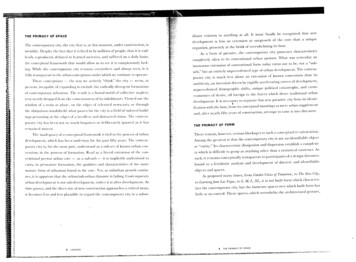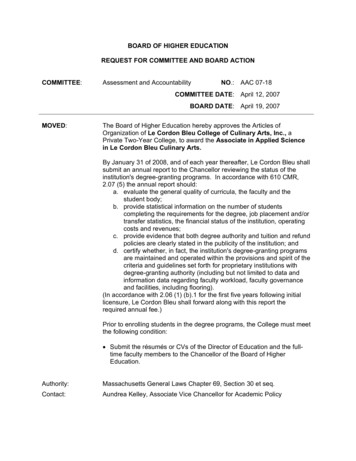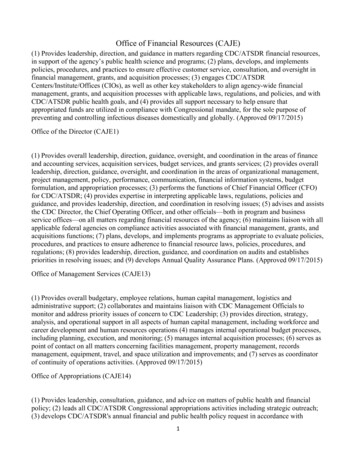
Transcription
dinate relation to anything at all. It must finally be recognized that newTHE PRIMACY OF SPACEdevelopment is less an extension or outgrowth of the core than a uniqueThe contemporary city, tlw city that is, at this moment, under constrllction, isinvisihle. Despite the fact that it is lived in by millions ofpeopk, that it is cnd It:ssly reproduced, debated in learned socie.ties, and sufferedorganism, presently at the brink of overwhelming its host.As a form of parasite, the contemporary city possesses characteristicsa daily basis,COtllpletely alien to its convcntional urban sponsor. What was yesterday anthe conceptual framework that would allow us to sec it is conspicliously lack innocuous extension of conventional form today tul'ns out to be, not a "snb ing. While the contelllporary city remains everywhere and always seen, it isurb," but an entirely unprecedented type of urban development. The contelU fully transparenl to Ihe urban conceptions under whieh we continueopnate.porary city is much less about an extension of known convention than itsseem, alantitlwsis, an inversion driven by rapidly accelerating curves of development,prcs(:nl, incapable of (:xpanding· to include Ihe radically divc.rgcnt forlllationsunprecedented demographic shifts, unique political catastrophe, and exoticof contemporary urbanism. Thc result is a brulal world of collcdive neglect,economies of desire, all /()reign to the forces which drove traditional urbanvery nearly droppcd from the consciousncss ol"its inhabitants. Viewed out thedcvelopnH nt. It is nc.cessary to separate this new parasitic city frOlll its identi window of a t rain or planc, on I he edges (If Ic/evised newscasts,J'ication with the host, from its conceptual moorings as mCfe urban supplementThcsc conceptions -Oil10Ihe way we actively "think" the city -0('Ihroughthe ubiquitous windshield, what passes f(JI' thc city is a l"ield ol" lIlJ!ovcd build \and, after nearly l"ifly years of construction, attempt10raise it into discourse.ings persisting at the cdg"s of a hc.cdt.-ss aud distracted visiou. The. contelll porary city has becn not so ll1uch forgotten or delibnatciy igno]"( d as it hasTHE PRIMACY OF FORMrClllained unsecn.Thc inadequacy of a conceptual framework is lied 10 Ihe process of urbanThere rcmain, however, serious blockages to such a conceptual re-orientation.development, which has been underway for the past /Ifty years. The contcm Among the greatest is that the contemporary city is not all identifiable objectporary city is, fi)r the most part, understood as a sub-s( t of known urban con or "entity." Its characteristic dissipation and dispersion establish a complexi ventions in Ihe process of formatioll. Read as a literal extension of Ill ' con ty which is difficult to grasp as anythin, other than a statistical construct. Asventional prewar urban core -snch, it remains conceptlwlly transparentas a sllb-uriJ -it is implicitly uuderstood totoparticipants of a design discoursecarry, in prematurc formation, the qualities and characteristics of the nlOf( bound to a fetishistic analysis and development of discrete and ident ifiablcmature f(Jrll1 of llrbanism·/ilund in the corc. Yet, as suburban growth contin lies, il is apP lrent that the urban/sub-urban dynamic is failing, ContclllPoraryobjects and spaces.As proposed many times, from Garden Cities a/Tomorrow, to The New Ci v,IIrban development is not sub-development, rathn it is aiter-devcloprtlcilt. Asto Learningfrom Las Vegas, to S, M, L, XL, it is not built/ill'm which character time passes, and the sheer size of new consl ruction approaches a critical mass,izes the contemporary city, but the' immense spaces over which built form hasit becomes kss and less plausible to regard the contemporary city in a subor little or no control. These spaces, which overwhelm the architectural gesture,.2LADDERS3THE PRIMACY OF SPACE
.ultimately dominate the contemporary urban environment. Vastcontinuous orzones of urbanlots,undeveloped or razed parcels,hug-ecorporate plazas, high speed roads and urban expressways,the nowcordon sanitaire surrounding- oflice uarks. industrialtheme parks. malls and subdivisions arebecolllc theJI)CUSof;lllspaces which have Edler! toinvestigation. As a result the characteristicspaces of contemporary urbanrCm l11lnnseen and IIllder conceptual access to thesetheorizer!. Withouttifiable spaces, the contelllporaryunq uall remains inaccessible notto thosewho live in ii, hilt oftcn to those whoThis inaccessihility existsreason that the characteristicspaces of the contemporaryarc not idcnt iriablegaps, lacunae, hia tuses,words,and01'tha tbut rather are0111'afe unable to account for. Architects anti plan ners stick to the discrete and theulldermined by forceseven if their eft(ll'ts prove to betheir control. Against sllch llm:es, designersmust retreat to myopic sclf-t'x;tminatioll or, Illore frequently in urban dis course, to a time when design was indisputably privileged. \Vhat the city hasa designedbeenC "Ull'Udemit' andentity), dominates aca thinking- as a transparent attempt to regain Ollr I(Jr our fixation with the known and dcsignable, tomal and spatialthe0.1 Superstudio. "Live with objects, not for objects."Photocoflage, 1972."When design as an inducement to conswne ceases toneed to act, mold, transform, give, conserve, modify. cometo light." (Ambasl, 1970, p, 246)contrary, the primacy of built form.Thediscollrse around the actualIIIcon tcmpora ryof thestems rrom a near universal inability to abandon a prcoc not with rorm ltscll; but with thrrary urban environmcn l.4all evidc nec to thean emptyarea is created, in which, slowly, as on the surface of a mirror, sLichUlings asor t he "ctual st ate or 1111' conlcmporary urban cllvirolllncnL Tht:rcortcn seellls no greater priority than to preserve,Thi illSistcncc onLADDERS5THE PRIMACY OF SPACEof form ill the cOlltcmpo preempts theto
.any characteristic absence or lack without transforming- it intoelse, that is iuto something- architectural. The characteristicabst'llce or contemporary urban space cannot be confronted directly by designSPACE/FORMA critique of the primacy of built form in t he contemporary urban rnviroll mellt Ileed neit lead to thediscourse. Despite all claims to thl; contrary, nothing could be fartherremoved from contemporary urban n'oalilics than the old avant-garde tcndell cy (operatillg at Icast since Pirancsi) to constructor to art ielliate,with all Tll(·t'q)hysical ostentatioll, the architectural "Void." Such exercisesdirectintervcntioll into a space, a spacc whichtohecollles the kindthai till, contemporaryor aLscnccdo not10to('()nv( f1ti()lIalon, itlos( sThis absel1ce,desigu intervention, It cannot beits distinguishing qualities and hemmes presence,Ignoring this situatioulcads to the f'ailliliar, f'utile ('xcrciscs ill which(TSstatus istheOn 1 hedcuialOneTheatt( l1lpttlewhich is I!lOst characteristicn mainsinaccessibleur the most basic relatiolls in 11".110direcljelr lheorintcrvcnl inn.OPCIlSup allot her set of pos.)] a cathedral and aor, nlorcthe association between an urban stred andit: cstahlishcs, inO(lment,part, Ill(' aulonomollse Ihe more rccent dominancecOlltcmporaryicularhistorical nrban dev('I space, suchobu}ills illor space, The interaction between space and I( !'murban rclalion, but this relation lIlay beCOll only ifrcccllt and radical shirt toward thc spatial is acku()wlnlgc(L Thepot( ntialarchitectural intcFv(:lllion in th(' contcmporary city lies ill theofnrballislllt he logic of eOllvcnl ional urLall devel shirting dialectic is best expressed in, i(lr exalllPIe, the associationtwtwecn a piazza and arather than confronts thescale or the context. This cOllstillltcs a .rary, itthe contcmporary situation otherwiseaLamlouillg t he primacy oflmilt feJl'lIl is it possible to repo Olllyto affect vast ('xpanses of space wil h inclT('elnal oftenpathetic "design" gcs[llresCOil!orOpWCllt is t h, working dialectic betwccn built f(lrm and urban space, This sub ami archikcts scck to forlllally intnvclle in the coutcllll)()]'"ry cllviron 11](0111.abililics that a"I'set lip as all analytic or ,) design model. To state the obvious, whclI absence isf(ICllScditcnviroumentlus insitiOl1 limn so that it lIlay effectively respond to a city dominated by space,the UIICOtlstrllc!ct! kindcharacteristic or contemporary urbanis Ilollikeauscnce isis, Attempts to reinstate thein t he con! emporarymacy of form is notOhSClI]"('S,model[han whatsOllle!,1llCl detcrlJliJlnllacks,or constructTheor fixednihi)ism, irony, COHlI1Krcialortheassertion that[()fincan yel .tfcct space as space cont illllCS10effecl[ mll,The dramatic skewing of' the dial(·ctic toward the spatial is key to arevised strategy of urball intcrvcllti()lI. Out of a rigorous analysis of lhe('OI) temporary cily, a so-callcd "post-urban" sl rategy of inlervention em('l'g':s,Givell the continued intcrrdatioll h('(w('en contemporary space and for III , it6lADDERSfHE PRIMACY OF SPACE
to dran anurban strategy that aimsmary target of spaceaform is clearlyat the pri intervention of form. While builtthe dialectic between space and form rcmalllsoperative, iftheattempts toof space. BySPACE/TIMEBefore outlining this contemporary version ofWright. In his book, The Disa/)jJearing Ci J1, Wright advocated an extremeof the urban environment, far more radical than anyhere aimsat this inverted statns betweencontemporary urban space and form. The intent is towhatsoever. The pmjectbelween urban space ami lill'lIl docs existsreversed, It isbuil t li)!'lll.I11llStbeUlanyin thethetoem ctivcslIstain a blindllcss touf {()I'm alllllllnts to a certainintervention. Tothe primacy of space is togreater urban realities whose dfccts n'main trans parent to the contemporary urbanIOn.of the city.In support of the ultimat.e dissolulion of the city,analytical formulation: " . notarticulated a newhave space values cntlrdy changed totime values, now ready to form new standards oj' l1lovel1lent measurement, buta new sense of spacing based upon speed is here, . , . And, too, til/:engendered rresh spit'itllal as well asthis sense of space hasarchitectuI'al vocabularies arc rev-olntiollaryorysis withof built limllto sec the most st ridcnt P0lellllClsts -or tht'lJl unabashed l .mllalistsdispersal: thebnt an evanescentthe inability to sec and Ilmierstand thetraditionalmOll but anypursued by Lc Corbusierbuilt form. What would otherwise be an obvious course of actioll isnrban spacc. While a cohercntthe ccutralization andbefore or since. Broadacrc Cityand elabOl ll ean operative dialectic and repositioll contemporary urban space in relation tohowever,of conventional urbanemerged from the familiar if still surprising urban polemic of Frankof engag of space.The ideathe privileged status ofnote another strategy which fore'dullyarchitectural form. As far back as 1932, abuilt form can emerge as aor subordinate intervention that is neverthelessit is necessary tolime wasassociation of urban space withThisvalues" (Fislunan,reorient at ion to contc rnporarya necessary/(ll'urban devc:lopment, a rcorien tatioll still remarkably convincing. Rejl e.rat cd inthe ] l,)Os bv Melvin Webber (1963) and again in the 1970s by Paul Viriliot h(: agency of(1991), this conjunction of space and limein itsremainsAs it has evolVt'd, the1.0 I radilionalurhan1()[,)1l.suggests the dissolutionor urbanrUl'minlo the temporal vectors of transportatiotl and communication networks. Thespeed of a vehicle onfreeway, or radio and I.e levisionital communication has usurpedthe contemporary nrban environmcllt isIn this8LADDERS9THE PRIMACY OF SPACEor oflelTitorial domaills establishedCOlli posedandform.reCOlll
.posedeach individualaround literal and virtual itineraries, andnot in relation to a fixed arrangement of places. The city is tied together, nOISp lCC and builtbut by thisexeclltedspace in realeffort to enlist its remainder into positive outcomes. No matter how intensethe maelstrom of modernization becomes, howporate power,rary urban "dimension." The disappearance of thelions, bureaucratic organization,occurs wheu form com as it is measured over time. AsurbanbecomesemergeI\r(:there isa remainder of form, and this remai nderThecess of trJl1sfOl'mationVirilio is clear:Il1to accept a reuersalit can beunder the dramatic and often disastrous pro will not be replacedofThe. to co/uiliN 1t101!(:rIWIIIall emplacemcnl withoulal )' /Jlwise plate, without l!,t:ometric or geo,E;wpltic localzzation, a.1 with the /JartzclesqUllnlurn mechanics:' We must at lemt resolve 1J1lrsdVc.f to lo.lin,t; tlte sewe l!l0ur Jl'I1ses.willmon "emf and certainlic", in tfw rna/erial of rejlrescntatioll. We mll.ll be rca({v to loseour rnorlJ/wlol'ical illusion.! about bhv.\'ical dimensions, (Virili{), 199/,Thisdigital revolu new rulesthe traditional dialectic hetweenspace and built form. 011 the overthrow ofteehnolo we arc to scientific analyses, industrial processes, cor·gies, or howtime. In this way, time is aflinncd as the legitimate increment of cotHempo pletely dissolves as it is disengaged from space and space is engagedcolonizer!and the disappearance of form will be taken upclear that I h( it isli)ur. At thisstrategy out of form and the irrt'lcvancelined above lies somrwhcre betwecn theof form. III addressing the radical skewing of the diakctic between /tmn andspace, wc arc amrming the validity of formalsimply because builtI()rrn is subordinate, it is not irrelevant. In this case, we have chosen anspace over time in its ahilit y to enter Into a materialrelation with form, the /()],]l1al prerogatives which constitute the basis or archi inevitable abdication of physical fOl'ln is the flip side ofprivilt"ge of /tlrm. The extremestcctul'alpromoted range from the absol!lte pri maey of built t"rl1l to the absolute irrelevance of built limn. There is littledouht that limni"that theamI that theinto theof speed has ovt't'writlcn ollr most funda mental urban ccrt linties.never beAN IDEA OF FORM IN A CITY OF SPACE
2 LADDERS . 0.1 Superstudio. "Live with objects, not for objects." Photocoflage, 1972. "When design as an inducement to conswne ceases to an empty area is created, in which, slowly, as on the surface of a mirror, sLich Ulings as need to act, mold, transform, give, conserve, modify. come to light." (Ambasl, 1970, p, 246) 4 LADDERS ultimately dominate the contemporary urban environment. Vast .











